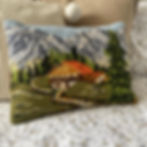DIY Project- Turn a Tapestry Project into a Cushion
- LittleFigHandmade
- Mar 26, 2024
- 3 min read

There’s something incredibly special about hand stitched projects like tapestry, needlepoint, embroidery or cross stitch, knowing the hours and dedication that went into making such a treasured project. Michelle recently finished this fabulous vintage tapestry kit, and instead of mounting and framing, we thought it would be a great piece to turn into something a little different – a cushion cover.
If you don’t happen to have a hoard of vintage German tapestry kits like Michelle does, this project will also work with other similar pieces like finished cross stitch, or embroidery work. You can frequently (sadly I always think as they take such time and love to create!) find projects like these in charity shops, and these will need a gentle hand wash and press before you begin.
Follow below for a quick and easy method...
1. Cut out the panel for the front of your cushion from your tapestry or project. Ideally you need to have about 2cm around the border of your project to allow for generous seams for the wear it will undergo when it is sat on or fluffed. If you are worried about the fabric your project is stitched on fraying or coming apart, you may wish to overlock the raw edge to help avoid this. Depending on your project, it will likely be a rectangle or square.
2. Next cut out your two back panels. You need two as you are going to create an easy envelope style back – no need to go hunting for a zip for this project!! The first panel should be half the width of the front panel, and the second panel should be ¾ of the width of the front panel.
3. Hem one side of both of these panels, this will create a neat edge for your envelope opening.

4. Place your front panel piece down, right side facing up (so you will see the correct side of your tapestry or project facing up). Next place down the longer back panel, wrong side facing up. This should be placed over the left side of your front panel, and a small area of the project should still be showing on the right.
5. Lay the other back panel over the other side of the front panel, covering the area that is still showing, lining up the raw edges. The hemmed edges you created earlier should be overlapping in the middle.

6. Pin in place. Do not pin along the finished opening.
7. Sew around all four sides of your rectangle/square, leaving no opening. Be sure to backstitch when starting and finishing your seam, using at least a 2cm seam allowance
8. Turn your cushion cover out the right way through your envelope flap, and poke out the corners so they point nicely. You may wish to trim away some of the seam allowance for a neater shape, but be aware this will affect the durability of your cushion depending on the fabrics used. Press if required, ideally using a pressing cloth to avoid damaging the stitching on your project.


9. Insert your cushion inner through the envelope opening in the back.

And you're done! I for one am incredibly jealous that Michelle gets to have this super cute vintage cushion in her living room!
Tag us in your cushion projects @little.fig.handmade on Instagram if you try out this DIY!
- Charis
